
Lomatium is a genus in the family Apiaceae. It consists of about 100 species native to western Northern America and northern Mexico. Its common names include biscuitroot, Indian parsley, and desert parsley. It is in the family Apiaceae and therefore related to many familiar edible species such as carrots and celery; some Lomatium species are extensively used by Native Americans in the inland Northwest as a staple food.
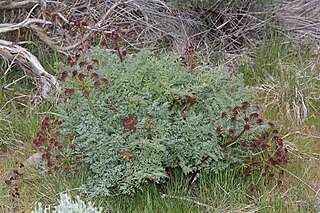
Lomatium dissectum is a species of flowering plant in the carrot family known by the common names fernleaf biscuitroot and fernleaf desert parsley. It is native to much of western North America, where it grows in varied habitat. It is found in the eastern slopes of the Cascade Range, Rocky Mountains, Klamath Mountains, eastern Transverse Ranges and the Sierra Nevada in California.
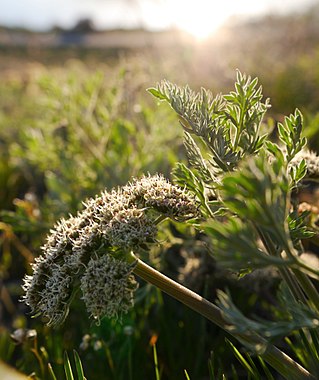
Lomatium macrocarpum is a perennial flowering plant in the carrot family known by the common names bigseed lomatium, biscuit root or bigseed biscuitroot. It is native to much of western North America, where it can be found in various types of habitat, including the grasslands of the Great Plains, and particularly in rocky areas. It is a spreading or erect perennial herb growing up to about half a meter long with hairy, gray-green herbage. The grayish basal leaves are up to about 24 centimetres (9.4 in) long and are intricately divided into many small, narrow segments. The inflorescence bears an umbel of yellowish, greenish, purplish, or white flowers, growing from a lateral stem. The fruit is a compressed, winged, round or oval disc up to about 2 cm long.
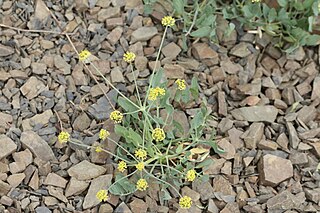
Lomatium nudicaule is a species of flowering plant in the carrot family known by the common names pestle lomatium, barestem biscuitroot, Indian celery and Indian consumption plant. It is native to western North America from British Columbia to California to Utah, where it is known from several habitat types, including forest and woodland. It is a perennial herb growing up to about 70 centimetres (28 in) tall from a thick taproot. It generally lacks a stem, the inflorescence and leaves emerging from ground level. The leaves are made up of many dull green, waxy lance-shaped leaflets each up to 9 cm long. The inflorescence is borne on a stout, leafless peduncle widening at the top where it blooms in an umbel of yellow or purplish flowers.

Lomatium roseanum, adobe parsley, also known as adobe lomatium and rose-flowered desert-parsley, is a very rare plant of the Western U.S., known only from northwestern Nevada and southeastern Oregon, and which may also occur in northeastern California. The largest populations occur on the Sheldon National Wildlife Refuge. It is a member of the celery family, the Umbelliferae, and has yellow flowers.

Chaenactis douglasii is a North American species of flowering plant in the daisy family known by the common name Douglas' dustymaiden.

Chrysothamnus viscidiflorus is a species of shrub in the family Asteraceae of the Americas known by the common names yellow rabbitbrush and green rabbitbrush.

Eriogonum sphaerocephalum is a species of wild buckwheat known by the common names rock buckwheat and round-headed desert buckwheat. It is native to the western United States.

Lomatium canbyi is a species of flowering plant in the carrot family known by the common name Canby's biscuitroot. It is native to the Pacific Northwest of the United States and northeast California, where it grows in sagebrush-covered plateau habitat and barren flats.

Lomatium columbianum is a perennial herb of the family Apiaceae known by the common names purple leptotaenia and Columbia desert parsley. It is endemic to the U.S. states of Oregon and Washington, mostly along the Columbia River east of the Cascades.

Lomatium cuspidatum is a perennial herb of the family Apiaceae, native to the U.S. state of Washington. It is found primarily on open rocky slopes in the Wenatchee Mountains, strongly associated with serpentine scree and soils.

Lomatium donnellii is a perennial herb of the family Apiaceae, in the Western United States.

Lomatium foeniculaceum is a species of flowering plant in the carrot family known by the common name desert biscuitroot. It is native to much of western and central North America, where it grows in many types of habitat.
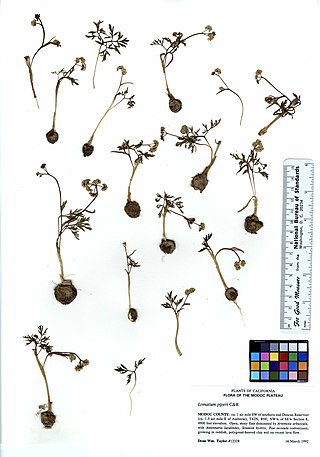
Lomatium piperi is a species of flowering plant in the carrot family known by the common name salt-and-pepper or Indian biscuitroot. It is native to the Northwestern United States and northern California, where it grows in sagebrush and plateau habitat, and the Sierra Nevada and Cascade Mountains.
Lomatium ravenii is a species of flowering plant in the carrot family known by the common names Lassen parsley and Raven's lomatium. It is native to the Great Basin of the United States, where it grows in sagebrush and other plateau habitat, including areas with somewhat alkaline soils in Nevada, California, and other states.

Lomatium triternatum is a species of flowering plant in the carrot family known by the common name nineleaf biscuitroot. It is native to western North America from British Columbia to California to Colorado, where it grows in many types of habitat. It is a hairy perennial herb growing up to a meter tall from a taproot. The leaves emerge from the lower part of the stem. Each is generally divided into three leaflets which are each subdivided into three linear leaflike segments. The inflorescence is an umbel of yellow flowers, each cluster on a ray up to 10 centimeters long, altogether forming a flat formation of umbels.

Thelypodium laciniatum is a species of flowering plant in the mustard family known by the common name cutleaf thelypody. It is native to western North America, particularly the Great Basin and surrounding plateau and foothill habitat, where it grows on dry rocky cliffs and hillsides in sagebrush and scrub, usually below 2,400 metres (8,000 ft) elevation.
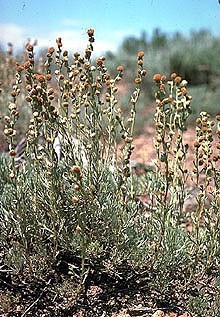
Artemisia papposa is a species of flowering plant in the aster family known by the common names Owyhee sage, Owyhee sagebrush, and fuzzy sagebrush. It is native to the Snake River Plain and surrounding areas in the northwestern United States, occurring in southern Idaho, eastern Oregon, and northern Nevada.
Lomatium papilioniferum is a species of Lomatium previously included in the Lomatium grayi complex. It is native from southern British Columbia to northern California and east to Idaho and Nevada. It occurs in dry lowland areas including sagebrush desert.
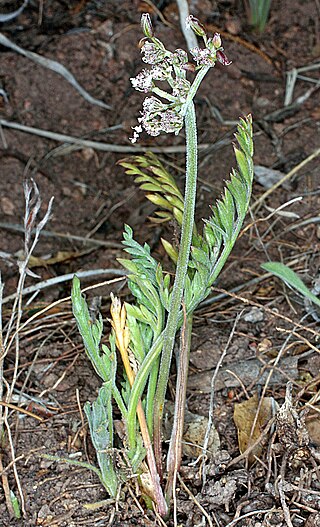
Lomatium orientale, commonly known as salt-and-pepper, eastern cous, eastern desert-parsley, eastern lomatium, white-flowered desert-parsley, oriental desert parsley or Northern Idaho biscuitroot, is a small spring blooming ephemeral plant. It grows in open habitats from the plains to foothills in western North America. It is known as one of the earliest blooming native flowers in its habitat. The species name, "orientale", is botanical Latin meaning "eastern".




















